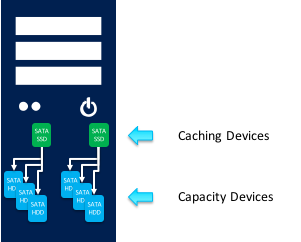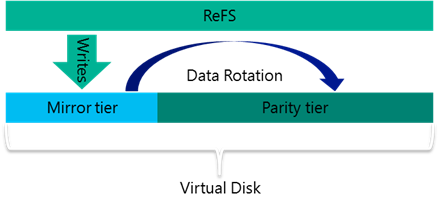Before Technical Preview 5, Windows Server enabled to create Storage Pool with a mix of type of disk as SSD and HDD, NVMe and SSD or NVMe and HDD. Moreover, Technical Preview 4 brings multi-resilient virtual disk which is a multi-tier Storage Spaces (mirroring tier and parity tier). Since Technical Preview 5, Windows Server 2016 enables to use a mix of NVMe + SSD + HDD disks to obtain a triple tiers storage solution. Let’s see how it’s work J
Storage Spaces Direct
Storage Spaces Direct is a solution where you can implement a cluster of 3 nodes or more and use the storage devices of each server to create a clustered storage solution. The storage devices can be located internally or in direct-attached JBOD tray and connected by using SAS, SATA or NVMe connection. For more information about Storage Spaces Direct, you can read this whitepaper.

Storage Spaces Direct can be implemented with a mix of storage device type as SATA or NVMe SSD and HDD. Storage Spaces Direct implements a cache mechanism called Storage Bus Cache to support the read + write cache when using HDD or just the write cache when using NVMe SSD + SATA SSD. The cache devices are always the fastest storage devices. For example, when using SSD and HDD, the SSD will be the cache devices and HDD the capacity devices. When using NVMe SSD and Sata SSD, the NVMe SSD will be the cache devices and the SSD the capacity devices.
| Storage Configuration | Caching devices | Capacity devices | Caching behavior |
| SATA SSD + SATA HDD | All SATA SSD | All SATA HDD | Read + Write |
| NVMe SSD + SATA HDD | All NVMe SSD | All SATA HDD | Read + Write |
| NVMe SSD + SATA SSD | All NVMe SSD | All SATA SSD | Write only |
The cache devices are bound to capacity devices with the round robin algorithm. If a cache device fails, the capacity devices associated with it will be bound to another cache device.
 HDD
HDD
Multi-Resilient Virtual Disk
In Technical Preview 4, Microsoft has implemented the Multi-Resiliency Virtual Disk which enables to create a virtual disk with two tiers. The first tier is a mirroring tier and the second is the parity. Mirroring is optimized for performance but the capacity is lower than parity because of duplication of data (two times or three times). the parity is efficient for archival / backup because the capacity is maximized but the performance is lower than mirroring.
To use the benefit of each resilient type, Windows Server 2016 enables to create a two tiers virtual disk where hot data are located in the mirror tier and the cold data are located in parity tier.

When the mirror tier is full, the data are rotated the the parity tier by using ReFS Real-Time Tiering. So the volume inside the virtual disk must be formatted by using ReFS file system. When a data located in a parity tier must be updated, the data is written in mirror tier and the data is invalidated in the partiy tier.

To be able to use this feature, you must have at least four nodes in the Storage Spaces Direct cluster. Below you can find the different volume types:
| Optimized for | Performance | Efficiency | Balanced performance and efficiency |
| Use case | All data is hot | All data is cold | Mix of hot and cold data |
| Efficiency | Least (33%) | Most (50+%) | Medium (~50%) |
| File System | ReFS or NTFS | ReFS or NTFS | ReFS only |
| Minimum nodes | 3+ | 4+ | 4+ |
Triple tiers configuration
Since Technical Preview 5, Windows Server enables to use three types of storage devices for the Storage Spaces Direct solution. So you can have cluster nodes with NVMe SSD, SATA SSD and SATA HDD. In this way the storage devices are used as the following:
- NVMe SSD: Cache mechanism
- SATA SSD: Mirror tier (Multi-Resilient Virtual Disk)
- SATA HDD: Parity tier (Multi-Resilient Virtual Disk)

Thanks to the above solution, the cache is managed by the high performance NVMe disks. Then data are written on the SSD which are efficient. Then when hot data volume is full, the data rotation occurs and they are moved to the cold data tier. Because this tier is a parity tier, the capacity is maximized.
External link
- NVMe, SSD and HDD storage configurations in Storage Spaces Direct TP5
- Storage Spaces Direct in Technical Preview 4
- Hardware options for evaluating Storage Spaces Direct in Technical Preview 4
- Storage Spaces Direct in Windows Server 2016 Technical Preview
- Storage Spaces Direct – Under the hood with Software Storage Bus
- Understand Microsoft Hyper-Converged Solution







So, if I understand correctly, triple tiering only makes sense with hybrid mirror-parity volumes. Do you have any idea about what happens if you use it on a mirror-only volume? Both SSDs and HDDs are used uniformly for capacity?
Thanks,
Sergio
This feature is now called Mirror-Accelerated Parity. To use this feature, usually you create a volume with a mirror part and a parity part. If you do standard hybrid solution (SSD+HDD), I recommend you mirroring for VM and Parity for backup.